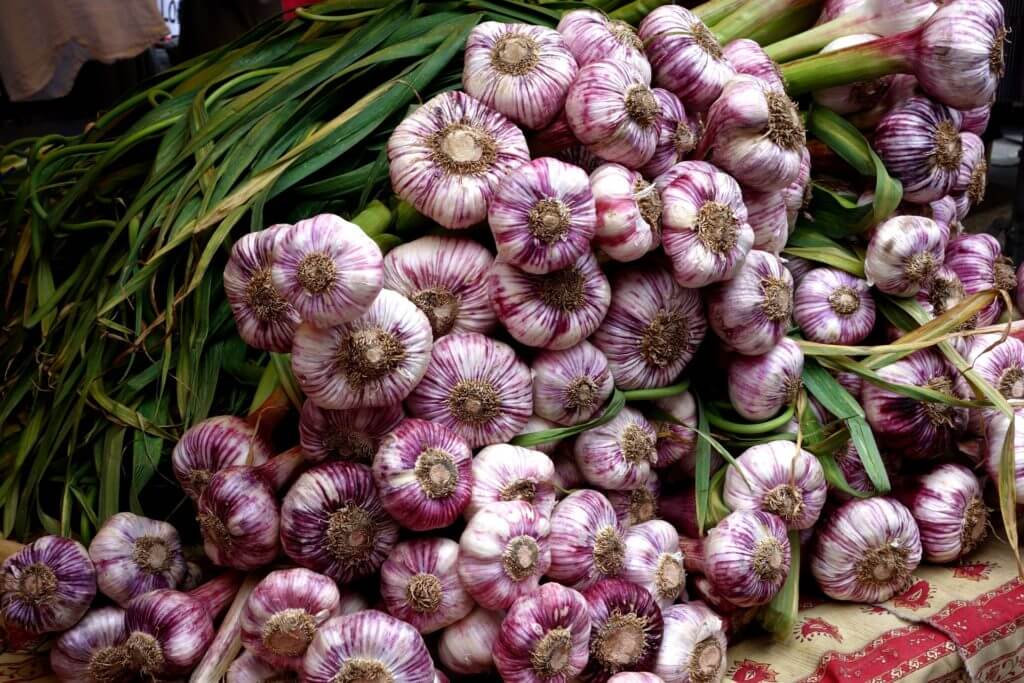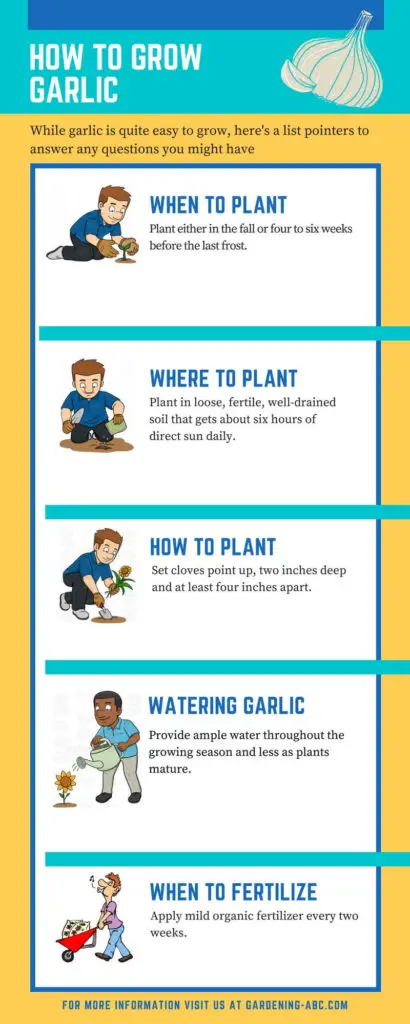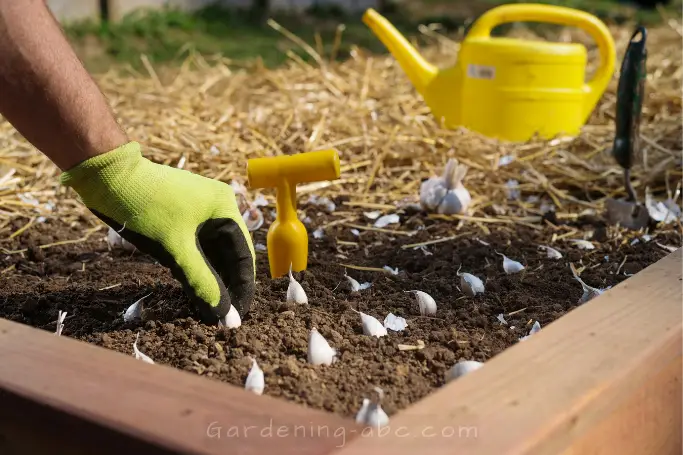We use affiliate links to run our site. When you buy through links on our site, we may earn an affiliate commission, without any added cost to you. Learn more
Garlic is a versatile and flavorful herb that you can grow in your own backyard. Whether you want to add some zest to your dishes, boost your immune system, or enjoy its many health benefits, garlic is an easy and rewarding crop to grow.
Garlic contains numerous health-promoting phytonutrients that are excellent against coronary artery diseases, infections, and cancers. They are also an excellent source of vitamin B6, manganese, selenium, and vitamin C.
You can easily grow garlic in your garden or in a pot, and enjoy its fresh flavor all year round.
In this blog post, we will teach you everything you need to know about growing garlic at home. You will learn how to plant garlic, how to take care of it, and how to harvest and store it properly.
So let’s get started…
A Brief About The Plant:
Garlic is a bulbous plant with a strong, pungent flavor. It consists of multiple cloves arranged in a head, covered by a papery skin. Each clove can be planted individually to grow a new garlic plant.
The scientific name of garlic: Allium sativum
Why Grow Garlic At Home?
At this point, if you are wondering okay, garlic is good for my health. But why should I even bother growing them in my house when I can buy them pretty cheap at the stores? Well, let me tell you this it’s cheap for a reason.
Do you know that in most cases, where garlic is mass-produced, they are treated with chemicals and bleached white with chlorine? If you are serious about the health and well-being of your family you don’t want to consume them no matter how cheap they are.
Yes, you can buy organic garlic in the market; but the price will pinch you. And after spending that much money too, you are never sure of its authenticity.
When you grow garlic organically, you get the best of both worlds. You can grow organic garlic in front of your eyes with very little spending.
Garlic also provides support to other plants in your garden. Garlic is a very useful companion plant.
It goes fantastically well with most of the fruit trees, Tomatoes, Peppers, Eggplant, Potatoes, Cabbage, Broccoli, etc. And the best part of growing garlic is that it is not that tough either. So wrap up your sleeves and stop making any excuses.
Types of Garlic:
There are basically 2 garlic varieties available in the market.
- Softneck Garlic
- Hardneck Garlic
1. Soft-neck variety: In this type of garlic the neck of the garlic stays soft after harvest. This variety is the easiest to grow and is recommended particularly for warmer climatic areas.
They have a very strong and intense flavor. Soft neck varieties also braid and store well.
2. Hard-neck variety: Here garlic has a stiff stem that dries to a rigid stick. And it makes braiding almost impossible. If you live in colder climatic areas this is the best garlic variety for you.
A nickel will get you on the subway, but garlic will get you a seat. Share on XHow To Grow Garlic:
To ensure a successful garlic harvest, it’s important to know when to plant garlic and follow proper planting techniques.
When to Plant Garlic?
The ideal planting time for garlic depends on various factors, including your geographical location and climate. However, garlic is typically planted in the fall or early spring.
Factors to consider:
When determining the best time to plant garlic, consider the following factors:
- Climate: Garlic planting time is greatly influenced by the climate in your region. Garlic requires a period of cold temperatures, known as vernalization, to form bulbs properly. In most regions, planting garlic in the fall allows it to undergo vernalization over the winter. However, in warmer climates, where winters are mild, planting in early spring may be more suitable.
- Geographical Location: The specific location where you reside plays a role in determining the best time to plant garlic. Different regions have varying climate patterns, frost dates, and growing seasons. Research your local agricultural extension office or consult experienced local gardeners to understand the ideal planting window for your area.
- Frost Dates: Garlic prefers cooler temperatures and is relatively frost-tolerant. Planting garlic too early in regions prone to late spring frosts can be risky, as the emerging plants may be damaged. Ensure that the risk of frost has passed before planting. On the other hand, if garlic is planted too late, it may not have sufficient time to establish roots and develop bulbs before the onset of hot summer weather.
- Soil Temperature: Garlic requires soil temperatures between 50°F and 70°F (10°C to 21°C) for proper growth. Planting garlic in soil that is too cold can result in slow germination and weak plant development. Use a soil thermometer to monitor the soil temperature and wait until it reaches the appropriate range before planting.
- Variety Selection: Different garlic varieties have varying growth and development timelines. Some varieties mature earlier, while others take longer to reach harvest readiness. Consider the specific variety you are planting and its recommended planting time to ensure a successful crop.
- Crop Rotation: If you are practicing crop rotation in your garden, take into account the rotation schedule when deciding when to plant garlic. Avoid planting garlic in the same location or a spot recently occupied by other allium family crops (such as onions or leeks) to minimize the risk of soil-borne diseases and pests.
- Availability of Seed Garlic: Seed garlic, which refers to the individual cloves used for planting, may have limited availability depending on the time of year. It’s important to plan ahead and secure your seed garlic in advance to ensure you have it when the optimal planting time arrives.
Planting Garlic:
The ideal soil for growing garlic has only three prerequisites:
- It should be fertile.
- It should be well-drained. and
- The soil pH should be between 6.5 and 7.0
How To Plant Garlic:
Garlic is grown from cloves. For growing garlic, you need to plant the cloves into the ground with the root end down and the pointed end up.
Choosing the cloves
When selecting garlic cloves for planting, choose large, healthy bulbs. Avoid cloves that are soft, damaged, or discolored. Each clove will grow into a new garlic plant, so it’s important to choose high-quality cloves.
Planting cloves from the grocery store can be a bad idea. They are generally treated with various chemicals to make their shelf-life longer. Instead, try your local nurseries or seed-selling companies for the cloves.
Break the cloves from the bulb but do not remove the papery husk which surrounds the individual cloves.
Pre-soaking cloves
To promote better germination, you can soak the garlic cloves in lukewarm water for a few hours before planting. This helps to hydrate the cloves and kickstart the sprouting process.
Preparing the bed
Select a place where sun exposure is good.
Prepare the planting bed by removing any weeds and loosening the soil. Incorporate organic matter, such as compost or well-rotted manure, into the top layer of soil to improve its fertility. Garlic requires plenty of nitrogen so choose your compost ingredients accordingly.
Rake the bed to create a smooth surface for planting.
Planting depth
Plant the garlic cloves with the pointed end facing up. The depth at which you plant the cloves depends on your climate and the size of the cloves.
As a general guideline, plant them about 2 inches deep in mild climates and 4 inches deep in colder regions.
Spacing and rows
Space the garlic cloves approximately 6 inches apart in rows that are 12 to 18 inches apart. This spacing allows room for the garlic plants to grow and develop their bulbs. Planting in rows makes it easier to weed and harvest later on.
If you are growing garlic make sure your soil has a good amount of nitrogen in it Share on XCaring for Garlic
Once you have planted the garlic cloves, it’s important to provide proper care to ensure their healthy growth.

Watering and mulching:
Garlic plants require consistent moisture throughout their growing period. The water requirement is normally not huge, an Inch deep water every week is more than enough.
Stop water once the leaves begin to yellow. This will help to make the bulbs firm.
Water the plants regularly, especially during dry spells. Avoid overwatering, as excessive moisture can lead to rotting.
Applying a layer of mulch around the plants helps retain moisture and suppresses weed growth.
Fertilizing:
Garlic plants benefit from a balanced fertilizer application. About a month after planting, you can apply a nitrogen-rich fertilizer to encourage leafy growth.
Avoid using excessive amounts of nitrogen, as it may promote excessive foliage at the expense of bulb development.
Weed control:
Weeds can compete with garlic plants for nutrients and water, so it’s important to keep the planting bed weed-free. Regularly inspect the bed and remove any weeds by hand or use organic weed control methods.
Avoid using herbicides, as they can harm the garlic plants.
Pest and disease:
Garlic has very few pest problems. Rather it is a pest repellent. That is why in organic pest controlling methods, using garlic is a common phenomenon.
One of the very few pests that sometimes creep into your garlic is onion thrips and aphids. You can control the, easily using organic insecticides or by introducing beneficial insects.
Diseases such as white rot or garlic rust can be prevented by practicing crop rotation and ensuring proper soil drainage.
Harvesting and Storage
Knowing when to harvest garlic is crucial for obtaining flavorful bulbs and maximizing their storage life.

When to Harvest Garlic:
Garlic is ready for harvest when the leaves start to turn yellow and dry out. Dig up a test bulb to check for maturity. The cloves should be plump and well-formed, and the outer skin should be papery.
Harvesting process
Carefully lift the garlic bulbs from the soil using a garden fork or shovel. Be gentle to avoid bruising or damaging the bulbs.
Shake off any excess soil and leave the plants to dry in a well-ventilated area for a couple of weeks. This drying period allows the outer layers of the bulbs to dry and cure.
Drying and curing
After harvesting, it’s important to cure the garlic bulbs properly to enhance their flavor and storage life. Hang the plants in bundles or lay them in a single layer in a well-ventilated, dry area away from direct sunlight.
Allow the bulbs to cure for about two to three weeks until the foliage is completely dry and the skins have become papery.
How to Store Garlic:
Once the garlic bulbs have been properly cured, it’s time to prepare them for storage. Trim off the roots and cut back the stem to about an inch above the bulb. Store the bulbs in a cool, dry, and well-ventilated location.
You can keep them in mesh bags, or baskets, or hang them in braids. Properly stored garlic can last several months, allowing you to enjoy its flavors long after harvest.
Garlic as Companion Plant:
Apart from its intense flavor and culinary uses, garlic is a very good insect repellent and thus it is used widely in companion planting. For more information read about companion planting and its benefits in our earlier article.
Final Thoughts:
Thank you for reading this post on how to grow garlic at home. We hope you found it useful and informative.
Garlic is an amazing herb that can spice up your meals, improve your health, and beautify your garden. If you follow the steps we outlined in this post, you will be able to grow your own garlic with ease.
Please share this post with anyone who might be interested in growing garlic too. You can also check out more articles on our site for more gardening advice and inspiration.
Don’t Forget To Pin It

Can I plant garlic in the spring instead of the fall?
While fall is the ideal time to plant garlic, you can also plant it in early spring in regions with milder climates. Just ensure that the garlic undergoes vernalization, either naturally during winter or by refrigerating the cloves for a few weeks before planting.
How do I know when my garlic is ready to harvest?
Garlic is ready to harvest when the leaves turn yellow and dry out. Test the readiness by checking the bulbs for plump cloves and papery outer skin. It’s better to harvest slightly early than late to avoid the bulbs splitting or rotting.
Can I use store-bought garlic cloves for planting?
While you can use store-bought garlic cloves for planting, they are often treated with growth inhibitors to prevent sprouting. It’s best to purchase garlic specifically for planting from a reputable seed supplier to ensure optimal growth.
How often should I water my garlic plants?
Garlic plants require regular watering, especially during dry spells. Aim to keep the soil evenly moist but not waterlogged. Water deeply once or twice a week, adjusting the frequency depending on rainfall and soil moisture levels.
How long can I store harvested garlic?
When properly cured and stored, garlic can last several months. Store the bulbs in a cool, dry, and well-ventilated place away from direct sunlight. Check them periodically and use any cloves that show signs of deterioration.
Amazon and the Amazon logo are trademarks of Amazon.com, Inc, or its affiliates.

Hi there! My name is Prasenjit and I’m an avid gardener and someone who has grown a passion for growing plants. From my hands-on experience, I have learned what works and what doesn’t. Here I share everything I have learned.
